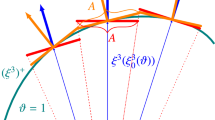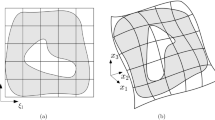Abstract
In this two-part paper, a stable and efficient nodally-integrated reproducing kernel particle method (RKPM) approach for solving the governing equations of generalized thermomechanical theories is developed. Part I investigated quadrature in the weak form using classical thermoelasticity as a model problem, and a stabilized and corrected nodal integration was proposed. In this sequel, these methods are developed for generalized thermoelasticity and generalized finite-strain plasticity theories of the hyperbolic type, which are more amenable to explicit time integration than the classical theories. Generalized thermomechanical models yield finite propagation of temperature, with a so-called second sound speed. Since this speed is not well characterized for common engineering materials and environments, equating the elastic wave speed with the second sound speed is investigated to obtain results close to classical thermoelasticity, which also yields a uniform critical time step. Implementation of the proposed nodally integrated RKPM for explicit analysis of finite-strain thermoplasticity is also described in detail. Several benchmark problems are solved to demonstrate the effectiveness of the proposed approach for thermomechanical analysis.















Similar content being viewed by others
References
Abouelregal AE, Zenkour AM (2013) The effect of fractional thermoelasticity on a two-dimensional problem of a mode I crack in a rotating fiber-reinforced thermoelastic medium. Chin Phys B 22(10):108102
Adam L, Ponthot J-P (2005) Thermomechanical modeling of metals at finite strains: first and mixed order finite elements. Int J Solids Struct 42(21–22):5615–5655
Armero F, Simo JC (1993) A priori stability estimates and unconditionally stable product formula algorithms for nonlinear coupled thermoplasticity. Int J Plast 9(6):749–782
Baek J, Chen J, Zhou G, Arnett K, Hillman M, Hegemier G, Hardesty S (in press) A semi-Lagrangian RKPM with node-based shock algorithm for explosive welding simulation. Comput Mech
Bagri A, Taheri H, Eslami MR, Fariborz S (2006) Generalized coupled thermoelasticity of a layer. J Therm Stresses 29(4):359–370
Bathe K-J (2006) Finite element procedures. Klaus-Jurgen Bathe, Berlin
Beni YT, Movahhedy MR (2010) Consistent arbitrary Lagrangian Eulerian formulation for large deformation thermo-mechanical analysis. Mater Des 31(8):3690–3702
Camacho GT, Ortiz M (1997) Adaptive Lagrangian modelling of ballistic penetration of metallic targets. Comput Methods Appl Mech Eng 142(3–4):269–301
Cattaneo C (1958) On a form of the heat equation eliminating the paradox of an instantaneous propagation. Account Render 247:431–433
Chen J, Dargush GF (1995) Boundary element method for dynamic poroelastic and thermoelastic analyses. Int J Solids Struct 32(15):2257–2278
Chen J-S, Hillman M, Chi S-W (2016) Meshfree methods: progress made after 20 years. J Eng Mech
Chen J-S, Hillman M, Rüter M (2013) An arbitrary order variationally consistent integration for Galerkin meshfree methods. Int J Numer Methods Eng 95(5):387–418
Chen J-S, Liu WK, Hillman M, Chi SW, Lian Y, Bessa MA (2017) Reproducing Kernel approximation and discretization. In: Stein E, de Borst R, Hughes TJR (eds) Encyclopedia of computational mechanics, 2nd edn. Wiley, Chichester
Chen J-S, Pan C, Roque C, Wang H-P (1998) A lagrangian reproducing kernel particle method for metal forming analysis. Comput Mech 22(3):289–307
Chen J-S, Pan C, Wu C-T, Liu WK (1996) Reproducing Kernel Particle Methods for large deformation analysis of non-linear structures. Comput Methods Appl Mech Eng 139(1–4):195–227
Chen J-S, Wu C-T, Yoon S, You Y (2001) A stabilized conforming nodal integration for Galerkin mesh-free methods. Int J Numer Methods Eng 50(2):435–466
Chen J-S, Wu Y (2007) Stability in Lagrangian and semi-Lagrangian reproducing kernel discretizations using nodal integration in nonlinear solid mechanics. In: Advances in meshfree techniques. Springer, pp 55–76
Chen J-S, Yoon S, Wu C-T (2002) Non-linear version of stabilized conforming nodal integration for Galerkin mesh-free methods. Int J Numer Methods Eng 53(12):2587–2615
Chen J-S, Zhang X, Belytschko T (2004) An implicit gradient model by a reproducing kernel strain regularization in strain localization problems. Comput Methods Appl Mech Eng 193(27–29):2827–2844
Chester M (1963) Second sound in solids. Phys Rev 131(5):2013
Danilouskaya V (1950) Thermal stresses in elastic half space due to sudden heating of its boundary. Pelageya Yakovlevna Kochina 14:316–321
Eringen AC (1980) Mechanics of continua. Robert E. Krieger Publishing Co., Huntington
Fan Z, Li B (2019) Meshfree simulations for additive manufacturing process of metals. Integr Mater Manuf Innov 8(2):144–153
Green AE, Lindsay KA (1972) Thermoelasticity. J Elast 2(1):1–7
Guan P-C, Chen J-S, Wu Y, Teng H, Gaidos J, Hofstetter K, Alsaleh M (2009) Semi-Lagrangian reproducing kernel formulation and application to modeling earth moving operations. Mech Mater 41(6):670–683
Guan P-C, Chi S-W, Chen J-S, Slawson T, Roth MJ (2011) Semi-Lagrangian reproducing kernel particle method for fragment-impact problems. Int J Impact Eng 38(12):1033–1047
Hillman M, Chen J-S (2016) An accelerated, convergent, and stable nodal integration in Galerkin meshfree methods for linear and nonlinear mechanics. Int J Numer Methods Eng 107:603–630
Hillman M, Chen J-S, Chi S-W (2014) Stabilized and variationally consistent nodal integration for meshfree modeling of impact problems. Comput Part Mech 1(3):245–256
Hosseini SM, Sladek J, Sladek V (2011) Meshless local Petrov-Galerkin method for coupled thermoelasticity analysis of a functionally graded thick hollow cylinder. Eng Anal Bound Elem 35(6):827–835
Hosseini-Tehrani P, Eslami MR, Azari S (2006) Analysis of thermoelastic crack problems using Green-Lindsay Theory. J Therm Stresses 29(4):317–330
Hughes TJ (2012) The finite element method: linear static and dynamic finite element analysis. Dover Publications Inc, Mineola
Hughes TJR, Winget J (1980) Finite rotation effects in numerical integration of rate constitutive equations arising in large deformation analysis. Int J Numer Methods Eng 15(12):1862–1867
Kouchakzadeh MA, Entezari A (2015) Analytical solution of classic coupled thermoelasticity problem in a rotating disk. J Therm Stresses 38(11):1267–1289
Li B, Habbal F, Ortiz M (2010) Optimal transportation meshfree approximation schemes for fluid and plastic flows. Int J Numer Methods Eng 83(12):1541–1579
Li S, Liu WK (1998) Synchronized reproducing kernel interpolant via multiple wavelet expansion. Comput Mech 21:28–47
Li S, Liu WK (2002) Meshfree and particle methods and their applications. Appl Mech Rev 55(1):1–34
Lindgren L-E (2006) Numerical modelling of welding. Comput Methods Appl Mech Eng 195(48):6710–6736
Liu WK, Jun S, Zhang YF (1995) Reproducing kernel particle methods. Int J Numer Methods Fluids 20(8–9):1081–1106
Lord HW, Shulman Y (1967) A generalized dynamical theory of thermoelasticity. J Mech Phys Solids 15(5):299–309
Mallik SH, Kanoria M (2009) A unified generalized thermoelasticity formulation: application to penny-shaped crack analysis. J Therm Stresses 32(9):943–965
Marusich TD, Ortiz M (1995) Modelling and simulation of high-speed machining. Int J Numer Methods Eng 38(21):3675–3694
Norris DM Jr, Moran B, Scudder JK, Quinones DF (1978) A computer simulation of the tension test. J Mech Phys Solids 26(1):1–19
Pan X, Wu CT, Hu W, Wu Y (2019) A momentum-consistent stabilization algorithm for Lagrangian particle methods in the thermo-mechanical friction drilling analysis. Comput Mech 64(3):625–644
Prevost J-H, Tao D (1983) Finite element analysis of dynamic coupled thermoelasticity problems with relaxation times. J Appl Mech 50(4a):817–822
Puso MA, Zywicz E, Chen JS (2007) A new stabilized nodal integration approach. Lect Notes Comput Sci Eng 57:207–217
Seitz A, Wall WA, Popp A (2018) A computational approach for thermo-elasto-plastic frictional contact based on a monolithic formulation using non-smooth nonlinear complementarity functions. Adv Model Simul Eng Sci 5(1):5
Sherief HH, El-Maghraby NM (2005) A mode-I crack problem for an infinite space in generalized thermoelasticity. J Therm Stresses 28(5):465–484
Sherief HH, El-Maghraby NM, Allam AA (2013) Stochastic thermal shock problem in generalized thermoelasticity. Appl Math Model 37(3):762–775
Simkins DC, Li S (2006) Meshfree simulations of thermo-mechanical ductile fracture. Comput Mech 38(3):235–249
Simo JC, Miehe C (1992) Associative coupled thermoplasticity at finite strains: formulation, numerical analysis and implementation. Comput Methods Appl Mech Eng 98(1):41–104
Tehrani PH, Eslami MR (2000) Boundary element analysis of coupled thermoelasticity with relaxation times in finite domain. AIAA J 38(3):534–541
Vernotte P (1958) Les paradoxes de la theorie continue de l’equation de la chaleur. Comptes rendus 246:3154–3155
Wang H, Liao H, Fan Z, Fan J, Stainier L, Li X, Li B (2020) The Hot Optimal Transportation Meshfree (HOTM) method for materials under extreme dynamic thermomechanical conditions. Comput Methods Appl Mech Eng 364:112958
Wu CT, Wu Y, Lyu D, Pan X, Hu W (2020) The momentum-consistent smoothed particle Galerkin (MC-SPG) method for simulating the extreme thread forming in the flow drill screw-driving process. Comput Part Mech 7(2):177–191
Wu J, Wang D (2021) An accuracy analysis of Galerkin meshfree methods accounting for numerical integration. Comput Methods Appl Mech Eng 375:113631
Yang Q, Stainier L, Ortiz M (2006) A variational formulation of the coupled thermo-mechanical boundary-value problem for general dissipative solids. J Mech Phys Solids 54(2):401–424
Yousefi H, Kani AT, Kani IM (2019) Multiscale RBF-based central high resolution schemes for simulation of generalized thermoelasticity problems. Front Struct Civil Eng 13(2):429–455
Zamani A, Hetnarski RB, Eslami MR (2011) Second sound in a cracked layer based on Lord-Shulman theory. J Therm Stresses 34(3):181–200
Acknowledgements
Both authors greatly acknowledge the support of this work by Penn State, and the endowment of the L. Robert and Mary L. Kimball Early Career Professorship. The first author also acknowledges the support of the Missile Defence Agency through Karagozian and Case Inc. subcontract #PSU 190337.000. Proofing of this manuscript by Jennifer Dougal is also acknowledged and appreciated.
Author information
Authors and Affiliations
Corresponding author
Additional information
Publisher's Note
Springer Nature remains neutral with regard to jurisdictional claims in published maps and institutional affiliations.
Appendices
Appendix A: Small-strain thermoelasticity
With \(\eta ^p=0\), the Helmholtz free energy function (6) for thermoelasticity can be written as
For small-strain thermoelasticity, the free energy function is a function of strain and the temperature \(\phi (\varvec{\varepsilon },\theta )\) with
With the assumption (97) and (98), the dissipation inequality (2a) becomes
Which yields the constitutive relations
and
Assuming \(\varvec{\varepsilon }=\varvec{0}\) and \(\theta =\theta _0\) in the reference state, (101) becomes
where \(\varvec{\alpha }\) contains the thermal expansion coefficients, K is bulk modulus and
Also, the entropy for small strain can be expressed as
where \(|_0\) means that the quantity is evaluated at the reference state. With (100), (102), (103), and \(({\theta -\theta _0})/{\theta }\approx ({\theta -\theta _0})/{\theta _0}\), and The specific heat capacity is \(c_p=\theta \frac{\partial \eta }{\partial \theta }\approx \theta _0\frac{\partial \eta }{\partial \theta }\) the entropy (104) can be written as
Substitution of (105b) and \(\beta =3K\alpha \) into (7) with Fourier’s law (14) yields
With the assumption \(\theta \approx \theta _0\), the energy equation becomes
which is the same as (12).
Appendix B: Finite-strain thermoplasticity
First, taking time derivative of the Helmholtz free energy function one obtains
With the assumption (108) and (40), the dissipation inequality (2a) becomes
where \(\varvec{F}=\varvec{F}^e\varvec{F}^p\); \(\varvec{F}^e\) is the deformation gradient; \(\varvec{F}^e\) and \(\varvec{F}^p\) are the elastic and plastic part of the deformation gradient, respectively. Since \(\varvec{F}\), \(\dot{\varvec{F}}\), \(\theta \), and \(\dot{\theta }\) are arbitrary values, we obtain the constitutive relations of
where \(\varvec{P}\) is the first Piola-Kirchhoff stress.
Here we define (109) into two parts
where \(\varvec{\Sigma }=2\varvec{C}^e\frac{\partial \phi ^e}{\partial \varvec{C}^e}\) is the Mandel stress tensor; \(\varvec{C}=\varvec{F}^T \varvec{F}\) denotes the right Cauchy-Green tensor and \(\varvec{C}^e\) is the elastic part, and \(\varvec{D}^p=\text {sym}(\dot{\varvec{F}}^p \varvec{F}^{p-1})\) is the symetric part of the plastic velocity gradient. Substitution (108), (42) , and (111) into (7) with the Fourier’s law (4) yields
where the last term is the elasto-plastic heating.
The simplification can be written with a dissipation factor \(\chi \) and \(\text {D}_{\text {mech}}-\theta \frac{\partial \text {D}_{\text {mech}}}{\partial \theta }\) replaced with the total plastic power \(\dot{w}^p\)
In applications of metal thermoplasticity, the plastic dissipation is much greater than thermoelastic heating. Therefore, we rewrite the energy equation neglecting the thermoelastic heating
which is (43).
Rights and permissions
About this article
Cite this article
Hillman, M., Lin, KC. Nodally integrated thermomechanical RKPM: Part II—generalized thermoelasticity and hyperbolic finite-strain thermoplasticity . Comput Mech 68, 821–844 (2021). https://doi.org/10.1007/s00466-021-02048-8
Received:
Accepted:
Published:
Issue Date:
DOI: https://doi.org/10.1007/s00466-021-02048-8




